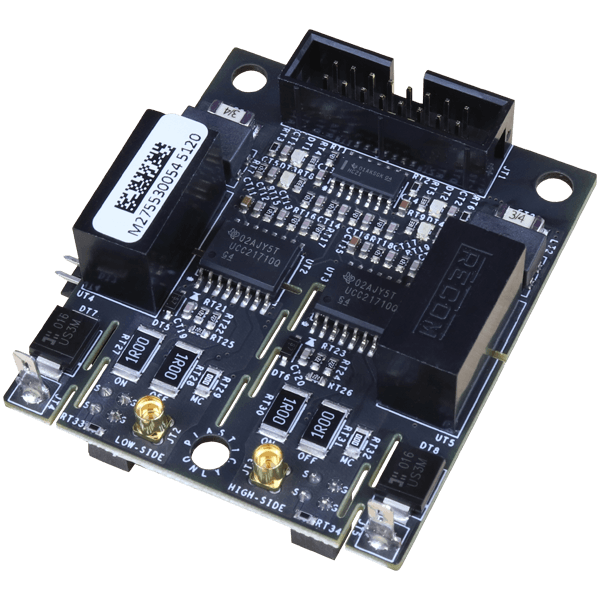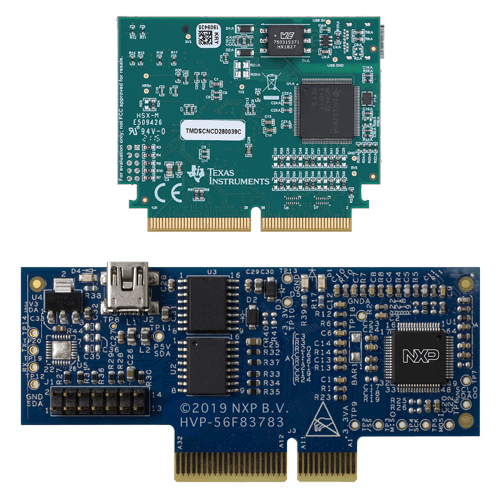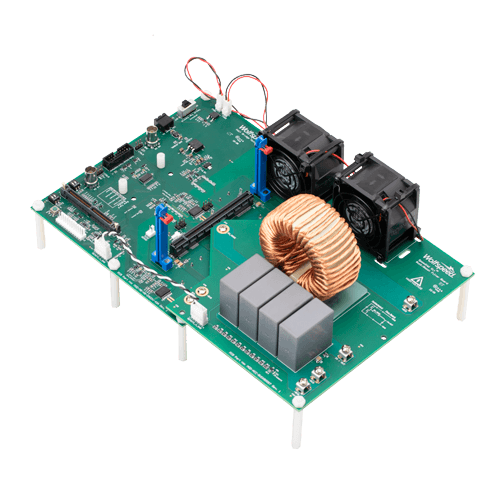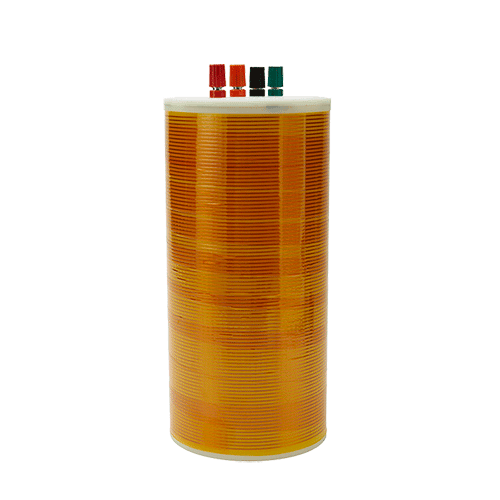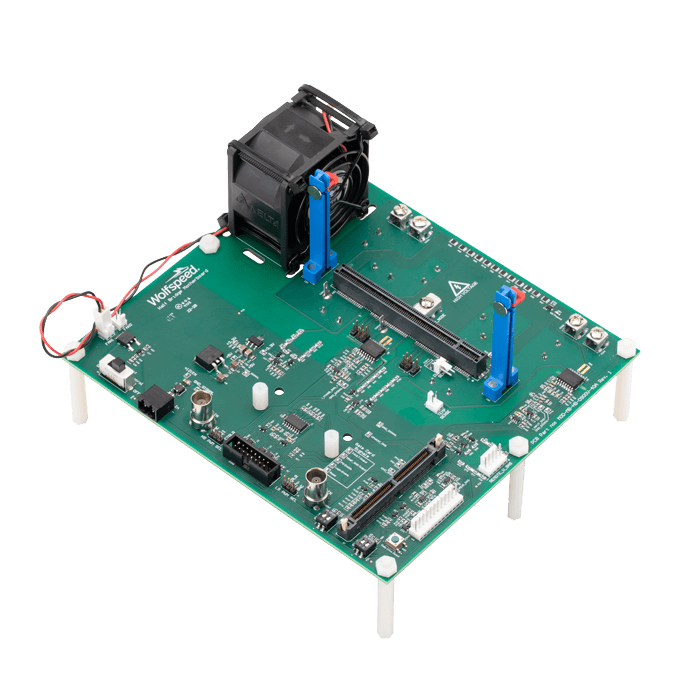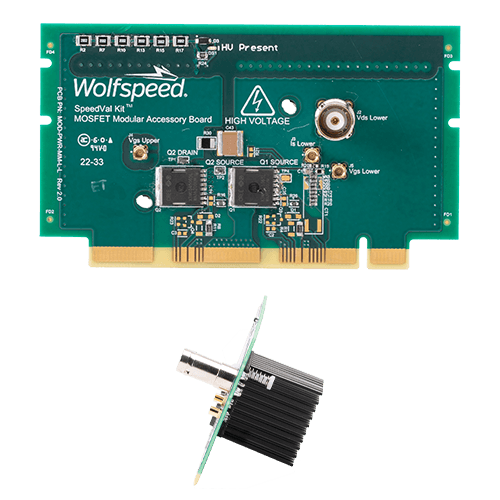Wolfspeed SpeedVal™ Kit Expands Control Options With NXP Cards
Article
Designers working with Silicon Carbide (SiC) evaluation kits, often built around just one SiC device, find themselves constrained to a narrow set of components for testing. Wolfspeed’s SpeedVal™ Kit takes a modular approach instead to offer designers the flexibility and customizability, and rapid, painless evaluation of multiple devices at the system level.
The kit’s building blocks form an ecosystem of Wolfspeed Silicon Carbide power daughter cards, partner gate driver and controller cards, as well as other accessories that engineers can easily switch on the motherboard. The card-edge connections mean devices can be tested and changed quickly without soldering.

Digital Control Optimizes Power Conversion
Among the SpeedVal Kit’s selection of daughter cards is NXP’s HVP-56F83783 high-voltage development card, featuring NXP’s 32-bit digital signal controllers. While these control cards are optional for using the SpeedVal Kit, they can help the engineer not only test the SiC and gate driver behavior in this system, they also provide an ideal environment to begin firmware development for their own design.
The first benefit to using an NXP control card in conjunction with the PC based user interface for SpeedVal Kit is that it comes with pre-tested firmware for operating the system as a buck or boost converter, or to apply gating signals for Double Pulse Testing (DPT) to investigate switching behavior. This can simplify the evaluation process by eliminating the need for an external function generator to drive the PWM signals, and incorporating some basic safety features and feedback signals to the user interface.

To take things to the next level, customers can extend the existing or develop their own firmware for the controllers. This allows the engineer to develop and test portions of the firmware that they will use in their own eventual design without having to develop any new hardware initially. Using this approach, firmware can be started months earlier in the development cycle and be validated on known-good hardware early in the design cycle.
Adding flexible, configurable control
The two controller cards offered as options with the SpeedVal Kit, host as the workhorse NXP’s leading 32-bit digital signal controllers (DSCs). The DSCs are based on a 32-bit 56800EX Hawk V3 core that offers 50 MHz normal-mode and 100 MHz fast-mode core frequency. The core’s modified dual Harvard architecture delivers DSP and MCU functionality in a unified, C-efficient architecture. It has 3 internal address buses and 4 internal data buses; flies though up to 100 MIPS in the fast mode; integrates an FIR filter 6X faster than the ARM Cortex-M3; offers fractional arithmetic; has superfast interrupt supported by software subroutine and interrupt stack; and allows priority-level setting for interrupts. The core engine includes JTAG/Enhanced On-Chip Emulation (OnCE) for real-time debugging independent of processor speed.
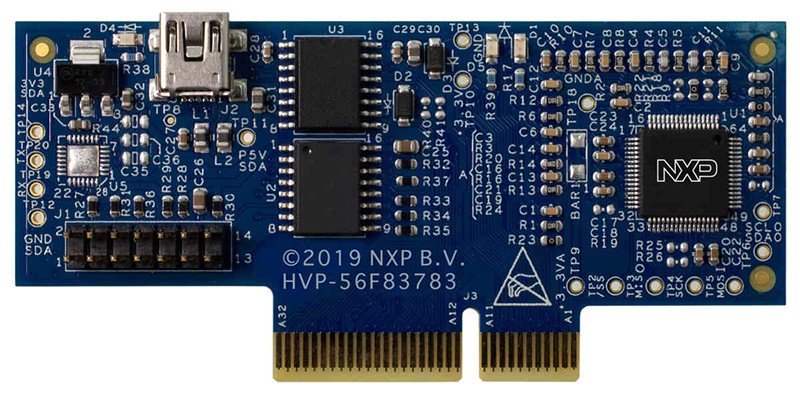
The HVP-56F83783 accommodates the MC56F83783VLH Digital Signal Controller (DSC). The onboard analog comparator (ACMP) and DACs allow inductor current and output voltage measurement for current-mode and voltage-mode control. A flexible eFlexPWM with multi-modes offers 312 ps resolution, synchronization to other PWM, multiple output trigger events, and independent top and bottom deadtime insertion. Both cards also offer basic safety features of over-voltage, over-current, and over-temperature protection.
The MC56F83783 offers the CAN FD (flexible data rate) interface, is AEC-Q100 qualified, and supports the Production Part Approval Process (PPAP), which implies that NXP understands customer designs and manufactures parts consistently to meet their requirements.
TheHVP-56F83783 supports many applications, including PFC, industrial motor control, large home appliances, EV charging, EV charging, solar inverters, and switched-mode power supplies. The higher performance HVP-56F83783 is particularly well-suited to automotive applications.
Firmware environment eases customization
The controller card flexibility and programmability are supported by NXP’s extensive firmware development support. The cards can be simply plugged into a computer via USB for designers to start configuring them with their installed tools.
NXP DSCs come with a free license for the CodeWarrior IDE, which runs on most operating systems, including Windows, Solaris, and Linux. The IDE allows designers to choose from multiple programming languages, such as C, C++, and Java, as well as in-line assemblers for most processors.
NXP also provides the MCUXpresso ecosystem, including a software development kit (SDK), as well as a suite of Configuration Tools. Designers can use the Config Toolsuite to shorten time to market by helping to set pins, clocks, and peripherals and generate initialization C code or register values for custom board support.


The FreeMaster visualization tool is extremely helpful for real-time debugging and data visualization when designing a control loop application. NXP’s tools and runtime software are complimentary, and assembly and C source code are provided under open-source licensing.
Growing ecosystem advantage
The NXP -56F83783 controller card is a part of Wolfspeed’s growing ecosystem supporting the SpeedVal Kit evaluation platform offering multi-supplier solutions. Serving as the starting point for all Silicon Carbide designs with bill of materials, design and simulation files, and expert support. This ecosystem approach allows customers to evaluate and develop all facets of a SiC power converter quickly and easily to help accelerate their product development and achieve first-pass design success. Learn more about the SpeedVal Kit at Wolfspeed.com/SpeedValKit and the NXP controller card options at NXP.com/dsc.
SpeedVal Kit Videos
Now Playing: Unboxing Wolfspeed’s SpeedVal Kit
What’s in the box? Join Wolfspeed Global Distribution Technical Manager Nick Powers as he unboxes the SpeedVal Kit Modular Evaluation Platform and highlights the advantages of using this flexible set of power building blocks for in-circuit evaluation of power system performance.
Available videos
Explore The Options
Click on the individual components of the system below to learn more and see the available options for each. Components may be purchased separately or use the SpeedVal Kit Configurator to build your complete test system.
